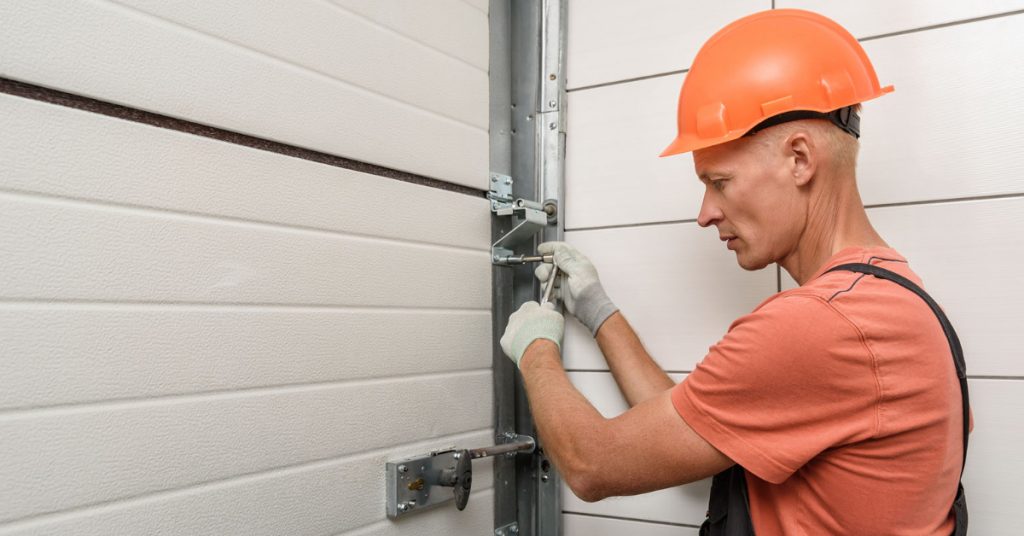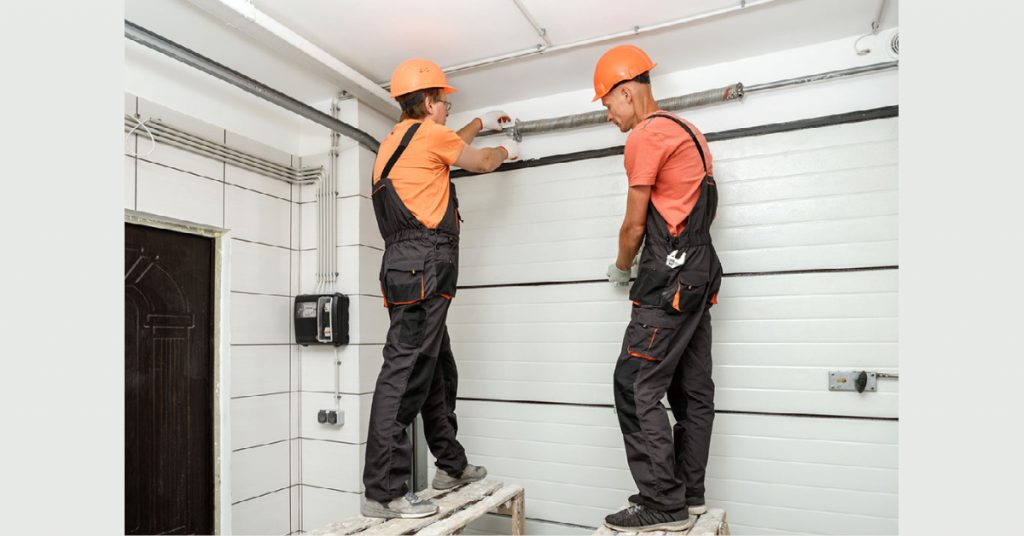Maximizing Energy Efficiency with Insulated Garage Doors
Hey there, fellow homeowners! Let’s dive into a topic that often flies under the radar: our garages. Believe it or not, they can be a major contributor to energy loss in our homes. But fret not, because in this article, I’ll be sharing some insights on the benefits of an energy efficient garage door.
We’ll explore various door materials to choose from and I’ll provide you with helpful suggestions on how to maximize energy efficiency in your own garage. Plus, I’ll walk you through some of the main steps to set in place your own garage door.
But more importantly, how to prep and approach the setup with the help of professional installer. Get ready to embark on this energy-saving adventure with me!
Insulated vs. Non-Insulated Garage Doors: Exploring the Key Differences and Benefits
Importance of Energy Efficiency in Garage Doors
When it comes to energy efficiency, our focus is often on windows, doors, and insulation within our homes. However, we tend to neglect the impact that an uninsulated or poorly insulated garage door can have on our energy bills. Garage doors, especially those attached to our homes, play a crucial role in maintaining the overall energy efficiency of the property.
Understanding Insulated Garage Doors
An energy efficient garage door are specifically designed to provide thermal resistance, reducing heat transfer between the interior and exterior of the garage. These doors are constructed using multiple layers of high-quality materials, such as polyurethane or polystyrene insulation, which effectively trap the air and create a barrier against outside temperatures.
Benefits of Insulated Garage Doors
Investing in insulated garage doors offers several benefits beyond being energy efficiency. These doors help to regulate temperatures inside the garage, resulting in a more comfortable space for various activities. Insulated doors also provide enhanced noise reduction, which is particularly beneficial for those who use their garage as a workshop or living area. Additionally, they improve the durability and strength of the door, enhancing security and overall lifespan.
Types of Insulated Garage Doors
Insulated garage doors come in various types, each offering unique characteristics and advantages. When selecting the right type of insulated garage door for your needs, it’s important to consider factors such as durability, maintenance requirements, style preferences, and budget. Let’s explore the different types of insulated garage doors in detail:
Steel Insulated Garage Doors
Steel insulated garage doors are among the most popular options due to their durability, strength, and low maintenance requirements. They consist of a steel skin with insulation material, usually polyurethane or polystyrene, injected within the door panels. The insulation provides excellent thermal resistance, reducing heat transfer between the interior and exterior of the garage. Steel doors are available in various designs, finishes, and colors, allowing homeowners to find a style that complements their home’s aesthetics.
Aluminum Insulated Garage Doors
Aluminum insulated garage doors offer a lightweight and contemporary option for those seeking energy efficiency and a modern look. These doors feature an aluminum frame with insulation material integrated into the panels. While aluminum is not as durable as steel, it is resistant to rust and corrosion, making it suitable for coastal areas or humid climates. Aluminum doors can be customized with different finishes and glazing options, allowing natural light to enter the garage.
Wood Insulated Garage Doors
Wood insulated garage doors provide a classic and natural look that adds warmth and elegance to any home’s exterior. These doors are constructed with a wood frame and insulation material, such as polystyrene or polyurethane, inserted between the panels. Wood offers excellent insulation properties and can effectively regulate temperature within the garage. However, wood doors require regular maintenance, including sealing, staining, or painting, to protect against moisture and prolong their lifespan.
Composite Insulated Garage Doors
Composite insulated garage doors are a popular choice for homeowners seeking a balance between durability, aesthetics, and energy efficiency. These doors are made from a combination of materials, typically including wood fibers or synthetic materials reinforced with resin. Composite doors offer the look of real wood while being more resistant to moisture, rot, and warping. They are available in various designs and can be painted or stained to match the desired style.
Fiberglass Insulated Garage Doors
Fiberglass insulated garage doors are lightweight, durable, and resistant to moisture, making them a suitable option for areas with high humidity or saltwater exposure. These doors consist of fiberglass panels with insulation material inserted between them. Fiberglass offers good thermal insulation properties and requires minimal maintenance. It is also available in different finishes, allowing homeowners to achieve a wood-like appearance without the maintenance associated with real wood doors.
Vinyl Insulated Garage Doors
Vinyl insulated garage doors are known for their durability, low maintenance requirements, and energy efficiency. These doors are constructed with vinyl panels and insulation material, providing good thermal resistance. Vinyl doors are resistant to dents, rust, and corrosion, making them suitable for harsh weather conditions. They are available in various designs and colors, allowing homeowners to choose a style that matches their home’s architecture.
When selecting the type of insulated garage door, it’s important to consider your specific needs, climate conditions, and budget. Consulting with a garage door professional can help you make an informed decision and ensure that the chosen door meets your requirements while maximizing energy efficiency.
Choosing the Right Insulated Garage Door
When selecting an insulated garage door, consider factors such as the R-value, which indicates the door’s insulation effectiveness. The higher the R-value, the better the insulation. Additionally, choose a door that complements your home’s aesthetics, ensures proper sizing, and offers features like weather sealing and energy-efficient glazing options.
Proper Installation of Insulated Garage Doors
Proper installation is essential to maximize the energy efficiency and functionality of insulated garage doors. While it’s possible to install a garage door yourself, hiring a professional installer ensures that the door is correctly fitted, minimizes air leaks, and maximizes insulation performance. Here are the key steps involved in the proper installation of insulated garage doors:
Step 1: Preparation and Safety Measures
Before beginning the installation process, it’s crucial to take necessary safety precautions. Ensure you have the required tools, equipment, and safety gear, including gloves, safety glasses, and a sturdy ladder. Read the manufacturer’s instructions thoroughly to familiarize yourself with the installation process and any specific requirements.
Step 2: Removal of Existing Door (if applicable)
If you’re replacing an existing garage door, start by removing the old door and its components. Carefully disengage the garage door opener and disconnect any electrical connections. Then, uninstall the door panels, tracks, springs, and hardware according to the manufacturer’s instructions.
Step 3: Door Frame Preparation
Inspect the door frame for any damage or rot. Repair or replace any compromised sections to ensure a solid and stable frame. Measure the opening’s width, height, and depth to determine the appropriate size of the new insulated door.
Step 4: Installing the Door Panels

Begin by installing the bottom panel of the energy efficient garage door. Secure it in place according to the manufacturer’s guidelines, ensuring it is level and plumb. Proceed to install the subsequent panels, connecting them securely using the provided hardware. Make sure to maintain uniform spacing between the panels for smooth operation.
Step 5: Track Installation

Install the vertical and horizontal tracks along the sides and ceiling of the garage. Secure them firmly using appropriate fasteners. Ensure the tracks are level and aligned, allowing the door to move smoothly. Attach any necessary brackets or supports as per the manufacturer’s instructions.
Step 6: Spring System and Hardware Installation

Install the spring system according to the specific type of garage door you have. Torsion spring systems require careful winding and installation, while extension spring systems require precise placement and tension adjustment. Follow the manufacturer’s instructions carefully, as incorrect installation can lead to safety hazards or door malfunctions. Install all other necessary hardware, including hinges, rollers, cables, and bottom brackets.
Step 7: Weatherstripping and Seals

To maximize insulation and prevent air leaks, install weatherstripping along the sides and top of the door frame. This helps create a tight seal between the door and the frame. Install a bottom seal or threshold seal to further enhance weather protection and insulation.
Step 8: Testing and Adjustment
Once the installation is complete, test the door’s operation to ensure it moves smoothly and without any obstructions. Check the balance and alignment of the door, making any necessary adjustments to ensure proper functionality. Test the safety features, including the auto-reverse mechanism, to ensure they are working correctly.
Step 9: Electrical Connections (if applicable)

If your garage door includes an electric opener, carefully follow the manufacturer’s instructions to connect and wire the opener system. Ensure proper grounding and secure wiring connections.
Step 10: Final Inspection and Maintenance

Conduct a thorough inspection of the entire installation to ensure all components are secure and in proper working order. Lubricate moving parts, such as hinges and rollers, with a recommended garage door lubricant. Regularly inspect and maintain your insulated garage door to prolong its lifespan and maintain optimal energy efficiency.
By following these proper installation steps or hiring a professional installer, you can ensure that your insulated garage door is installed correctly, minimizing air leaks and maximizing its energy-saving properties. Proper installation not only enhances energy efficiency but also improves the door’s functionality, durability, and overall performance.
Hiring Professionals for Insulated Garage Door Installation
When it comes to installing an energy efficient garage door, hiring a professional installer is highly recommended. Professional installers have the expertise, experience, and specialized tools necessary to ensure a proper and efficient installation. Here’s why it’s beneficial to enlist the help of professionals and what homeowners should do to prepare for the installation:
Benefits of Hiring Professional Installers
- Expertise and Experience: Professional installers have extensive knowledge and experience working with various types and brands of garage doors. They are familiar with the installation process and can handle any challenges or complexities that may arise.
- Proper Equipment: Installing a garage door requires specific tools and equipment that professional installers possess. They have access to the necessary tools, ensuring the job is done safely and efficiently.
- Safety Considerations: Garage door installation involves heavy components and tensioned springs, which can be dangerous if mishandled. Professional installers are trained to handle these elements safely, minimizing the risk of accidents or injuries.
- Warranty Compliance: Garage doors often come with manufacturer warranties. Professional installation ensures that the door is installed correctly, meeting the manufacturer’s specifications. This helps maintain the warranty’s validity, protecting homeowners from potential repair costs.
- Time and Convenience: Installing a garage door can be time-consuming, especially for those without prior experience. Professional installers can complete the installation quickly and efficiently, saving homeowners valuable time and effort.
Homeowner’s Preparation for a Professional Installation
Before the professionals arrive to install the garage door, homeowners can take a few steps to ensure a smooth and successful installation process:
- Research and Selection: Do thorough research to find reputable garage door installation companies in your area. Read reviews, check their credentials, and request quotes to compare pricing and services. Select a company that has a proven track record of quality installations and customer satisfaction.
- Clear the Garage: Remove any obstructions or items from the garage, ensuring a clean and spacious work area for the installation team. Clearing the space allows the installers to work efficiently and reduces the risk of damage to personal belongings.
- Provide Information: Communicate with the installation company about any specific requirements or concerns you may have regarding the installation. Share relevant details about the garage, such as its dimensions, construction materials, or any unique features.
- Ensure Accessibility: Clear the path to the garage and provide adequate parking space for the installation team’s vehicles. Remove any obstacles or vehicles that may hinder their access to the work area.
- Secure Pets and Children: To ensure everyone’s safety during the installation process, secure pets in a safe area away from the work zone. Keep children supervised and away from the garage to prevent accidents or distractions.
- Discuss Additional Services: If you require additional services, such as removing and disposing of the old garage door or installing a new garage door opener, discuss these requirements with the installation company beforehand. Clarify any associated costs and ensure they are included in the agreed-upon scope of work.
- Be Present and Communicative: While professional installers are skilled at their work, it’s beneficial for homeowners to be present during the installation. This allows for clear communication and ensures any questions or concerns can be addressed promptly.
By preparing for the professional installation of a garage door, homeowners can contribute to a smooth and successful process. Following these steps and hiring experienced professionals ensures a high-quality installation that maximizes the energy efficiency, functionality, and lifespan of the garage door.
Maintaining and Upgrading Insulated Garage Doors
Regular maintenance of your garage door is essential for long-term energy efficiency. Simple tasks like lubricating hinges and tracks, cleaning the door surface, and inspecting weatherstripping can go a long way in preserving the door’s insulation properties. Additionally, consider upgrading your door’s weatherstripping and seals if they show signs of wear and tear.
Energy-Efficient Practices for Garage Owners
Beyond insulated garage doors, there are other energy-efficient practices that garage owners can adopt. Proper insulation of garage walls, ceiling, and windows can further reduce heat transfer. Utilizing natural lighting or energy-efficient LED bulbs and installing programmable thermostats are additional measures that can contribute to energy savings.
Cost-Effective Solutions for Energy Efficiency
Maximizing energy efficiency doesn’t have to break the bank. Simple cost-effective solutions include sealing air leaks and using reflective materials on the garage roof to reduce heat absorption. These solutions not only save energy but also help lower utility bills in the long run.
Tips for Maximizing Energy Efficiency with Insulated Garage Doors
- Keep the garage door closed when not in use to minimize temperature fluctuations.
- Inspect the door’s weatherstripping regularly and replace if damaged or worn out.
- Install a garage door opener with energy-saving features, such as standby mode.
- Consider adding windows with energy-efficient glazing to allow natural light.
- Utilize smart home technology to control and monitor garage door usage.
Case Studies: Real-Life Energy Savings
Real-life case studies provide valuable insights into the energy-saving potential of insulated garage doors. These examples demonstrate the tangible benefits and significant energy savings that homeowners can achieve by investing in high-quality energy efficient garage door. Let’s explore a few compelling case studies showcasing the real-life energy savings experienced by individuals and families:
Case Study 1: The Johnson Family
The Johnson family resides in a region with extreme weather conditions, including scorching summers and frigid winters. Their attached garage had an uninsulated steel door, causing significant heat loss in winter and heat gain in summer. They decided to upgrade to an insulated garage door with a high R-value.
After the installation, the Johnsons noticed an immediate difference in their garage’s temperature and comfort level. The insulation provided excellent thermal resistance, minimizing the transfer of outdoor temperatures into the garage. As a result, they experienced a remarkable reduction in their heating and cooling costs, saving approximately 25% on their energy bills throughout the year.
Case Study 2: The Martinez Workshop
The Martinez family operates a workshop in their garage where they spend long hours working on various projects. They had an old, non-insulated aluminum garage door that allowed outside noise to penetrate the space, disrupting their concentration and productivity.
To address this issue, they replaced the old door with an insulated garage door featuring a high-density insulation material. The insulation significantly reduced noise transmission, creating a quieter and more conducive working environment. Additionally, the insulation helped regulate the temperature, ensuring a comfortable workspace throughout the year. As a result, the Martinez family experienced improved productivity and energy savings of approximately 20% on their heating and cooling costs.
Case Study 3: The Green Initiative Community
A community of environmentally conscious homeowners embarked on a neighborhood-wide initiative to reduce energy consumption and promote sustainability. As part of this initiative, many homeowners upgraded their garage doors to insulated ones.
The collective impact of these upgrades was astounding. The community witnessed a substantial decrease in overall energy consumption, thanks to the improved insulation provided by the garage doors. Homeowners reported energy savings of up to 30% on their heating and cooling costs, contributing to a greener and more sustainable neighborhood. The community’s success in energy reduction inspired others to follow suit, leading to a domino effect of energy-efficient upgrades throughout the area.
These case studies highlight the significant energy savings achieved by investing in insulated garage doors. By reducing heat transfer, enhancing temperature regulation, and minimizing energy loss, homeowners can experience substantial financial savings and a reduced environmental footprint.
Investing in anenergy efficient garage door not only improves energy efficiency but also enhances comfort, durability, and noise reduction. These real-life examples serve as powerful testimonials for the effectiveness of insulated garage doors in maximizing energy efficiency and achieving long-term cost savings.
The Future of the Energy Efficient Garage Door
As we move towards a more sustainable future, the development of insulated garage doors continues to evolve. Innovations such as advanced insulation materials, smart technology integration, and improved energy efficiency ratings are shaping the future of these doors. Embracing these advancements will help homeowners maximize energy efficiency while reducing their carbon footprint.
To Summarize
By investing in the right door, ensuring flawless installation, and adopting energy-efficient practices, we can make a significant impact. We’ll reduce energy consumption, enhance comfort, and pave the way for a greener future. Join the quest to maximize energy efficiency with insulated garage doors and embrace a more sustainable lifestyle. Let’s make a difference, one garage at a time!
FAQs
- Do insulated garage doors really make a difference in energy savings?
- Absolutely! As we learned in the case studies, an energy efficient garage door provide thermal resistance and help regulate temperatures, leading to substantial energy savings.
- Absolutely! As we learned in the case studies, an energy efficient garage door provide thermal resistance and help regulate temperatures, leading to substantial energy savings.
- How much can I expect to save on energy bills with insulated garage doors?
- Energy savings can vary based on factors such as climate, garage usage, and overall insulation. However, studies have shown potential savings of up to 20% on heating and cooling costs.
- Energy savings can vary based on factors such as climate, garage usage, and overall insulation. However, studies have shown potential savings of up to 20% on heating and cooling costs.
- Are insulated garage doors worth the investment?
- Yes, insulated garage doors are a worthwhile investment. They offer not only energy savings but also improved comfort, noise reduction, and increased durability.
- Yes, insulated garage doors are a worthwhile investment. They offer not only energy savings but also improved comfort, noise reduction, and increased durability.
- Can I install an insulated garage door myself?
- While DIY installation is possible, it’s recommended to hire a professional for proper installation to ensure optimal performance and energy efficiency.
- While DIY installation is possible, it’s recommended to hire a professional for proper installation to ensure optimal performance and energy efficiency.
- How long do insulated garage doors typically last?
- The lifespan of an energy efficient garage door doors can vary depending on usage and maintenance. However, with regular upkeep, they can last for many years, providing long-term energy savings




